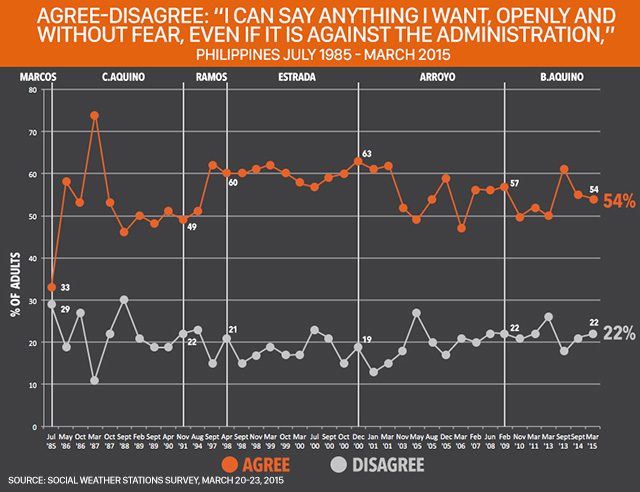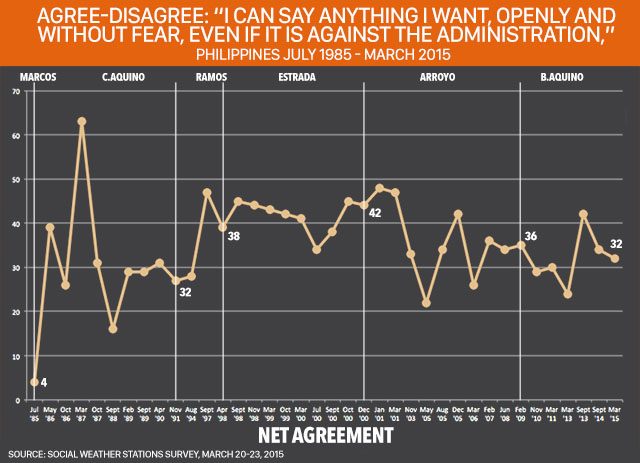SUMMARY
This is AI generated summarization, which may have errors. For context, always refer to the full article.

MANILA, Philippines – Over the past two decades or so, fewer Filipinos nationwide agree they enjoy freedom of speech – that is, speaking without fear.
After reaching its peak (net of 42%) under the administration of President Joseph Estrada that started in 1998, the freedom to speak one’s mind “without fear even if it is against the administration” dipped under the succeeding administrations of Gloria Macapagal-Arroyo (36%) and Benigno Aquino III (average of 32% as of March 2015).
The latest Social Weather Stations (SWS) survey – conducted March 20-23, 2015 – also showed that under Aquino’s administration, 54% of respondents agreed they could freely criticize the administration. It was lower compared to 55% in September 2014 and 61% in September 2013.

The Aquino administration got an average net agreement rate of 32% from November 2010 all the way to the first quarter of 2015. Aquino’s term ends in 2016 after the May elections. The 32% was described by SWS as “strong” agreement on the part of respondents.
The net rating is measured as the percentage of those who agree minus those who disagree.
Of the 4 previous administrations – excluding the Marcos administration that was rated only once in July 1985, and which got an extremely low 4% – it was the administration of Corazon Aquino that averaged the lowest in perceived freedom of speech at an average net of 32%.
During her presidency, she recorded the lowest net agreement rating in September 1988 with 16%. Her administration was threatened by a series of coup attempts by disgruntled members of the military, the most serious one led by then Colonel Gregorio Honasan in December 1989. Honasan went on to become senator.

Arroyo fared better than Corazon Aquino with a 36% average net agreement rating. President Fidel V. Ramos did even better with 38%. Estrada was tops with a 42% average.
According to SWS, a score of 50% and above signified “very strong” agreement with the statement: “I can say anything I want, openly and without fear, even if it is against the administration.”
30%-49% was considered “strong” agreement, 10%-29% as “moderate,” 9% to -9% as “neutral,” -10% to -29% as “poor,” -30% to -49% as “weak,” and -50% and lower as “very weak.”
Vocal Metro Manila
In the March 2015 survey, respondents in Metro Manila or the National Capital Region indicated strong net agreement (41%) about their freedom of speech compared to only moderate net agreement in Mindanao at 23%.
Balance Luzon and the Visayas each recorded 33%.

Among socio-economic classes, those who are better off registered a “very strong” net agreement at 59% compared to the very poor or class E that recorded a much lower 25% net. Thirty-two percent from Class D registered strong agreement.
When asked whether they agreed or disagreed with the statement, “The government listens to what people like me say,” nationwide, less respondents answered in the affirmative (49% in March 2015) compared to September 2013 (57%) and March 2013 (51%). Net agreement in March 2015 stood at 23%.

Net agreement was moderate and highest in Mindanao (25%) and lowest in the National Capital Region at 19%. By socio-economic class, net agreement was lowest with class D at 22%.

– Rappler.com
Add a comment
How does this make you feel?
There are no comments yet. Add your comment to start the conversation.